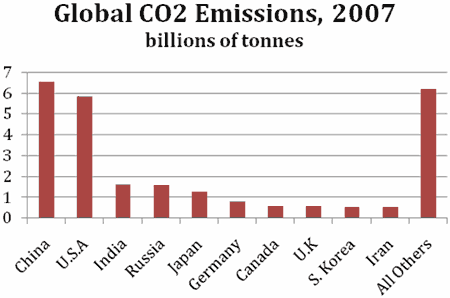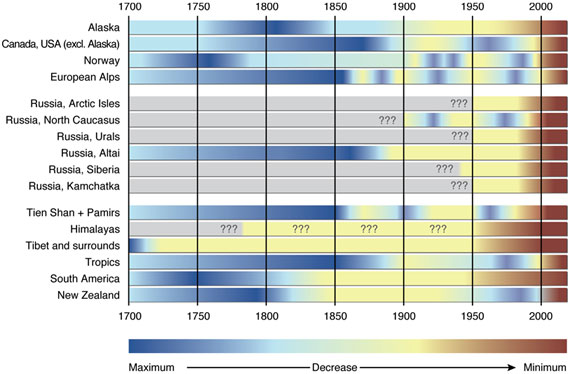
The largest source of increasing CO2 in the atmosphere since 1850 is from the burning of fossil fuels and vegetation, arising from human activity. These emissions pose a threat to the survivability of all on the planet. The following invites attention to the sources of CO2 emissions, some of their effects and measures which might be taken to enforce their reduction.
213 countries and territories are listed as emitting a total of 29.319 billion tonnes of CO2 in 2007.
52 countries, each emitting <1 million tonnes per annum, were responsible for 18.6 million tonnes (0.06%) of CO2 in 2007.
120 countries, each emitting <100 million tonnes per annum, were responsible for 2.683 billion tonnes (9.15%) of CO2 in 2007.
41 countries, each emitting >100 million tonnes per annum, were responsible for 26.618 billion tonnes (90.79%) of CO2 in 2007.

Fig. 1. The ten largest emitters were responsible for 76% of total anthropogenic emissions in 2007.
CO2 emissions into the atmosphere are increasing at a rapid and accelerating rate and are now at their highest level in 15 million years.
The Big Five: China, USA, India, Russia and Japan each emit over 1 billion tonnes of CO2 per annum. Their total emissions in 2007 were 16.781 billion tonnes, over 57% of anthropogenic emissions.
China and the USA are the largest emitters of CO2. In 2007 they emitted 6.538 and 5.838 billion tonnes respectively, over 42% of global emissions.
Neither country has committed to a reduction of their total emissions by 2020.
Both countries expect their emissions to rise for at least the next 20 years.
Japan emitted 1.172 billion tonnes of CO2 in 1990 and committed itself to reduce them by 20% or 237 million tonnes by 2020. By 2010 its emissions were 1.327 billion tonnes, an increase of 155 million tonnes or 13.2% on 1990 levels.
India expects its population to increase by 500 million over the next 20 years and its economy to rapidly expand. Consequently CO2 emissions are predicted to at least double, possibly treble over the next 20 years.
Russia significantly reduced its emissions in 1990 when it closed high polluting inefficient factories with collapse of the Soviet economy. Following the heatwave of 2010 which destroyed 20 percent of its grain crop and caused 50,000 deaths, it committed to reduce its 1990 emissions by 25 percent by 2020. Achievement of this target is questionable.
Australia is the largest exporter of coal in the world. Its 2008/09 coal exports were 261 million tonnes compared with production of some 70 million tonnes for domestic use.
Emissions from exported coal are over 3 times more than domestic emissions. Exported emissions are not recorded as Australian emissions but those of the countries in which the coal is burned.
Australia now emits more CO2 than France, a country with a larger more diverse economy and a population almost three times greater.
In 2008/09, major importers of Australian coal included Japan (104.8 million tonnes [Mt], 39.8%), Korea (43.1 Mt, 16.3%), Taiwan (26.1 Mt, 9.9%), China (25.0 Mt, 9.5%) and India (24.7 Mt, 9.4%), all countries with significant and growing CO2 emissions.
Increased greenhouse gas emissions produce global warming and global warming causes increases in the level of greenhouse gases entering the atmosphere from slow feedbacks including:
Melting of clathrate. Methane clathrate is an ice like substance found beneath sea floor sediment in polar regions. When melted by warming ocean water, it releases CH4 into the atmosphere at a rate of 168 litres per litre of solid clathrate.
Prior to 1750 the concentration of methane in the atmosphere was 0.7ppm but due to agriculture practices, mining and fossil fuel use is now 1.7ppm. In some parts of the Arctic it is nearly 2ppm due to melting of clathrates and permafrost.
Methane oxidizes to form CO2 over a period of ~15 years. During this period it is ~75 times more potent than CO2 as a greenhouse gas.
Solar energy reaching the earths surface is radiated back into space as long wave (infrared) energy. Greenhouse gases in the atmosphere, particularly CO2, absorb part of the solar energy radiated from the earths’ surface and emit some of it back to the earths surface – the greenhouse effect. This is causing average global temperatures to rise, more so in temperate and polar regions than in the tropics. The more CO2 in the atmosphere, the greater the rise in average global temperatures.
Sea Level: Ice sheets covering Greenland, East Antarctica and the marine ice sheet covering West Antarctica have begun melting at an increasing rate as a result of rising sea and atmospheric temperatures. Hansen and Sato (2011) predict that the rate of polar ice loss could double every decade.
Consequently, sea levels are also rising at an increasing rate. It is estimated that by 2100 this will result in average sea level rising by 0.8m – 2.0m though Hansen and Sato predict a rise of up to 5m. Sea level rise of this magnitude will cause flooding of low coastal lands, especially coastal cities where over 70% of the world population lives and the most fertile river deltas used for food production.
Land Erosion: As a general rule, for each centimeter rise in sea level, coastlines will be eroded by 1m or by 100m in the event of a 1m sea level rise. Coastal erosion of this magnitude will cause major damage to infrastructure such as roads, bridges, railways, airfields and to domestic, industrial and other buildings located on low-lying coastal land.
Fresh Water: As average global temperatures rise, they cause land based snow and glaciers to melt more rapidly than they can be replaced. In other words, they melt at an increasing rate, reducing the amount of water they yield each year for dependent ecosystems and human agriculture. The latter is now threatened.

Fig. 2. Overview on glacier changes since the end of the Little Ice Age. Glaciers and ice caps reached their Holocene (the past 10 000 years) maximum extent in most mountain ranges throughout the world towards the end of the Little Ice Age, between the 17th and mid-19th century. Over the past hundred years a trend of dramatic shrinking is apparent over the entire globe.
Courtesy: Hugo Ahlenius, UNEP/GRID-Arendal.
In California competition for water between people and agriculture has resulted in unsustainable pumping of groundwater. Fresh water sources in coastal areas are being made salt as a result of rising sea levels. By 2050 it is predicted that over half the estimated world population of 9.5 billion, will face water shortages.
Rainfall Changes: Climate scientists have long warned that rising air temperatures will increase water vapor in the atmosphere, change air flow patterns and precipitation in some areas. Increased rainfall is expected over tropical and high latitude areas with reductions occurring over the south-west and interiors of continents, the Mediterranean/Sahara and Central America.
For some parts this means drought conditions will persist or worsen (S.W. Australia,) while in others where rainfall has hitherto been adequate (the Amazon Basin, Zimbabwe), drought conditions may develop and become more frequent. Regions with adequate rainfall may get additional precipitation causing flooding, damaging property and agriculture.
Climate Events: As sea levels rise and air temperatures increase, the incidence of extreme or catastrophic weather events will increase and include destructive winds, drought conditions, heavy rainfall causing extensive flooding and high temperatures.
While there is little evidence that the 2010 Russian heat-wave or the Pakistan floods were produced by global warming, it is representative of extreme climate events which can be expected as world temperatures rise.
Ocean Acidity: As the level of CO2 in the atmosphere rises, the amount absorbed in colder seawater will increase, causing it to become more acidic. This reduces aragonite/calcites needed by marine animals to form shells – eg pteropods, corals, etc. and may reduce availability of iron required by phytoplankton. Loss of these animals poses a serious threat to the marine food chain on which humans and other animals depend for food.
Species Extinction: The rapidity with which climate changes are occurring threatens adaptive ability of some animal and plant species, both terrestrial and marine. Hansen (2008) notes that species unable to adapt will go extinct. They include those in a symbiotic relationship and those on which humans depend for food.
It has been suggested that we are at the start of a 6th mass extinction. This should be of concern to us since such an event affects our own ability to survive, particularly since it is occurring at a time when human population is reaching unsustainable levels.
Human Habitat: Serious threats to food crops on which a rapidly growing human population relies will arise from the above and attendant causes such as the spread of plant diseases, insects, other animal pests and, as experienced in Russia in 2010, agricultural losses from drought, heat and fire.
A combination of heat and humidity will kill an increasing number of animals, including homo sapiens, a species that can only survive a few hours in temperatures of 35°C and relative humidity >90%. Sherwood et al (2010) predicts these conditions will develop and spread, progressively reducing human habitat as global temperature rises, killing many as it does so.
The main culprits and countries responsible for CO2 emissions are known. The culprits are vested interests in the production and use of fossil fuels. The effects of their action are known and best summarised as risking our socio-economic destruction in pursuit of short-term profits.
Primary responsibility for limiting their activities and ensuring that average global temperature does not exceed 2°C by 2100 is vested in national governments. Those governments can and should be compelled to act responsibly by imposing a carbon tariff on national exports equivalent or related to the carbon emissions associated with their production. In short, imposition of a global price on carbon.
Posted by Riduna on Friday, 3 June, 2011
 |
The Skeptical Science website by Skeptical Science is licensed under a Creative Commons Attribution 3.0 Unported License. |